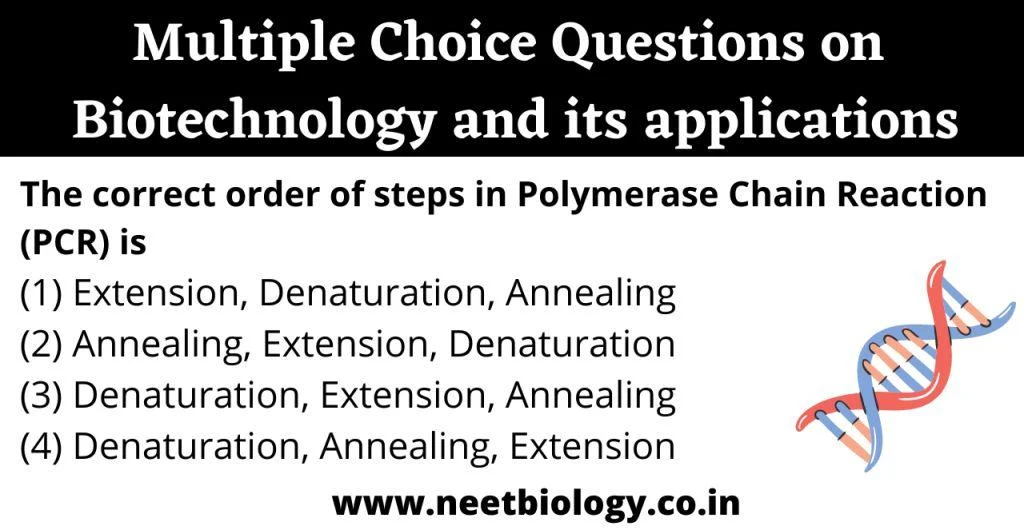1. Which of the following restriction enzymes produces blunt ends?
(1) Xho I (2) Hind III (3) Sal I (4) Eco RV
2. Which kind of therapy was given in 1990 to a four-year-old girl with adenosine deaminase (ADA) deficiency four-year-old?
(1) Immunotherapy (2) Radiation therapy (3) Gene therapy (4) Chemotherapy
3. Which of the
following method is not used for gene transfer.
(1) Biolistics
(2) Micropropagation
(3) Microinjection
(4) Agrobacterium co-culture
4. Gene silencing
using RNAi technique is applied to make:-
(1) Nematode resistant plant
(2) Edible vaccines
(3) Iron-fortified rice
(4) Vitamin enriched cereales
5. Which of the
following is not a genetically modified plant?
(1) Bt-cotton
(2) Flavr Savr tomato
(3) Pusa swarnim
(4) Golden rice
6. The DNA fragments
separated on an agarose gel can be visualized after staining with :
(1) Acetocarmine
(2) Aniline blue
(3) Ethidium bromide
(4) Bromophenol blue
7. The process of separation and
purification of expressed protein before marketing is called :
(1) Downstream processing
(2) Bioprocessing
(3) Postproduction processing
(4) Upstream processing
8. A gene whose
expression helps to identify transformed cells is known as :
(1) Vector
(2) Plasmid
(3) Structural gene
(4) Selectable marker
9. First plasmid of which bacterium is used as a vector in rDNA technique:-
(1) Salmonella (2) E.coli (3) Agrobacterium (4) Bacillus
10. Restriction endonuclease cut the DNA molecule at which site?
(1) Sugar-phosphate backbone
(2) Between two base pairs
(3) Between sugar and base
(4) Between phosphate and base
11. In r-DNA technology which part of Ti-plasmid of Agrobacterium is transferred to the host plant?
(1) T-DNA
(2) T-DNA + Vir-region
(3) T-DNA + Ori-region
(4) Vir-region
12. Match the
following :-
A Histone p Pectinase
B RNA q Cellulase
C Pectin r Protease
D Cell wall s Ribonuclease
Options:-
(1) A-p, B-q, C-r, D-s
(2) A-r, B-s, C-p, D-q
(3) A-s, B-r, C-q, D-p
(4) A-q, B-p, C-s, D-r
13. Which of the following is commonly used as a vector for introducing a DNA fragment in human lymphocytes?
(1) Retrovirus
(2) Ti plasmid
(3) l phage
(4) pBR
14. In India, the organization responsible for assessing the safety of introducing genetically modified organisms for public use is
(1) Indian Council of Medical Research (ICMR)
(2) Council for Scientific and Industrial Research(CSIR)
(3) Research Committee on Genetic Manipulation(RCGM)
(4) Genetic Engineering Appraisal Committee(GEAC)
15. A 'new variety of rice was patented by a foreign company such varieties have been present through in organizations India for a long time. This is related to
(1) Co-667
(2) Sharbati Sonora
(3) Lerma Rojo
(4) Basmati
16. Use of bioresources by multinational companies and organisations without authorization from the concerned country and its people is called
(1) Bio-infringement
(2) Biopiracy
(3) Biodegradation
(4) Bioexploitation

17. The correct order
of steps in Polymerase Chain Reaction (PCR) is
(1) Extension, Denaturation, Annealing
(2) Annealing, Extension, Denaturation
(3) Denaturation, Extension, Annealing
(4) Denaturation, Annealing, Extension
18. GEAC stands for:-
(1) Genetic engineering approval committee
(2) Genetic engineering agreement council
(3) Genetic engineering analysing crop
(4) Genetic engineering agricultural committee
19. A foreign DNA and plasmid cut by the same restriction endonuclease can be joined to form a
recombinant plasmid
using :
(1) Polymerase-III
(2) Ligase
(3) Eco RI
(4) Taq polymerase
20. Which of the following is not a component of downstream processing ?
(1) Preservation
(2) Expression
(3) Separation
(4) Purification
Answers:
1-4 | 2-3 | 3-2 | 4-1 | 5-3 | 6-3 | 7-1 | 8-4 | 9-1 | 10-1 |
11-1 | 12-2 | 13-1 | 14-4 | 15-4 | 16-2 | 17-4 | 18-1 | 19-2 | 20-2 |